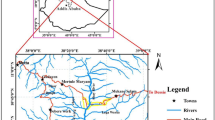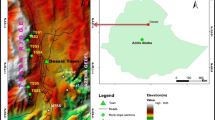Abstract
Investigating the instability of slopes containing weak rocks concerning construction projects such as rock–soil mixture slopes is always one of the challenging topics in civil engineering. This study investigates the role of three weak rocks in the instability of two trenches along the Yazd-Shiraz road. Physical, chemical, and mechanical properties were measured for the rock samples. The results showed that samples T2 (weak sandstone) and T3 (marly limestone) are less durable than sample T1 (hard sandstone). The soil sample covered trench 2 is a sandy soil (without cohesion with an internal friction angle of 47°) and has a significant effect on the instability of the trench. The instability of the trenches was investigated by the kinematic and discrete element methods. The results of the kinematic analysis showed that the discontinuities of trench 1 form critical intersections that can lead to wedge failure (occurrence potential of 36.36%). Also, the results showed the potential of planar sliding (18.18%) and toppling (14.54%) along trench 1. The results of numerical modeling showed that the alternation of weak and hard layers in trench 1, along with numerous discontinuities, caused the occurrence of rockfalls. Also, in trench 2, the failure occurred at the border of the surface soil and the weathered zone of the slope rock mass. The instabilities predicted by the developed numerical models were also observed in natural conditions. This confirms the ability of the models to predict the mechanism of failure in the rock cut slopes.









Similar content being viewed by others
References
Amini M, Sarfaraz H, Esmaeili K (2018) Stability analysis of slopes with a potential of slide-head-toppling failure. Int J Rock Mech Min 112:108–121. doi:https://doi.org/10.1016/j.ijrmms.2018.09.008
Ankah MLY, Kincal C (2022) Stability analysis of rock slopes using kinematic analysis and numerical modeling: Foça–Bağarası State Highway, Turkey. Model Earth Syst Environ. doi:https://doi.org/10.1007/s40808-022-01454-y
ASTM (2008) Standard Test Method for Slake durability of Shales and similar weak rocks, (D4644-04). ASTM International West Conshohocken, PA
ASTM (2017a) Standard test methods for liquid limit, plastic limit and shrinkage limit of soils, (D4318). American Society for Testing and Materials West Conshohocken, PA
ASTM D (2017b) 6913. Standard test methods for particle-size distribution (Gradation) of soils using sieve analysis. ASTM International: west Conshohocken, PA, USA
ASTM D (2011) Standard test method for direct shear test of soils under consolidated drained conditions. D3080/D3080M 3:9
Azarafza M, Asghari-Kaljahi E, Ghazifard A, Akgün H (2021) Application of fuzzy expert decision-making system for rock slope block-toppling modeling and assessment: a case study. Model Earth Syst Environ 7:159–168. doi:https://doi.org/10.1007/s40808-020-00877-9
Bar N, Barton N (2017) The Q-Slope method for Rock Slope Engineering. Rock Mech Rock Eng 50:3307–3322. doi:https://doi.org/10.1007/s00603-017-1305-0
Bekele A, Meten M (2022) Modeling rock slope stability using kinematic, limit equilibrium and finite-element methods along Mertule Maryam–Mekane Selam road, central Ethiopia. Model Earth Syst Environ. doi:https://doi.org/10.1007/s40808-022-01563-8
Berberian M, King G (1981) Towards a paleogeography and tectonic evolution of Iran: reply. Can J Earth Sci 18:1764–1766
Beyene BM, Assefa SM (2022) Slope deformation analysis along a gravel road from Arib Gebaye to Mekdela-Amba woreda, Northern Ethiopia. Model Earth Syst Environ. doi:https://doi.org/10.1007/s40808-022-01514-3
Bowa VM, Xia Y (2018) Stability analyses of jointed rock slopes with counter-tilted failure surface subjected to Block Toppling failure mechanisms. Arab J Sci Eng 43:5315–5331. doi:https://doi.org/10.1007/s13369-018-3168-4
Bushira KM, Gebregiorgis YB, Verma RK, Sheng Z (2018) Cut soil slope stability analysis along National Highway at Wozeka–Gidole Road, Ethiopia. Model Earth Syst Environ 4:591–600. doi:https://doi.org/10.1007/s40808-018-0465-6
Crusoe GE Jr, Cai Q-x, Shu J-s, Han L, Barvor Y (2016) Effects of weak layer angle and thickness on the stability of rock slopes. Int J Min Geo-Eng 50:97–110
Davoudzadeh M, Lammerer B, Weber-Diefenbach K (1997) Paleogeography, stratigraphy, and tectonics of the tertiary of Iran. Neues Jahrb Geol Palaontol Abh 205:33–67
Dong M, Zhang F, Lv J, Hu M, Li Z (2020) Study on deformation and failure law of soft-hard rock interbedding toppling slope base on similar test. Bull Eng Geol Environ 79:4625–4637. doi:https://doi.org/10.1007/s10064-020-01845-4
Erguler ZA, Karakuş H, Ediz İG, Şensöğüt C (2020) Assessment of design parameters and the slope stability analysis of weak clay-bearing rock masses and associated spoil piles at Tunçbilek basin. Arab J Geosci 13:41. doi:https://doi.org/10.1007/s12517-019-5030-8
Folk RL (1974) Petrology of Sedimentary Rocks: Austin, Texas, Hemphill Pub. Co 182
Franklin J (1985) Suggested method for determining point load strength. International Journal of Rock Mechanics and Mining Sciences & Geomechanics Abstracts, Elsevier, pp 51–60
Hajmolla Ali A (1993) Geological quadrangle map of Khezr Abad: series sheet 6753. Ministry of Mines and Metals, Geological Survey of Iran, Teheran
Ikeagwuani CC, Nwonu DC (2021) Influence of Dilatancy Behavior on the Numerical modeling and prediction of Slope Stability of stabilized expansive soil slope. Arab J Sci Eng 46:11387–11413. doi:https://doi.org/10.1007/s13369-021-05764-8
Kundu J, Sarkar K, Verma AK, Singh TN (2021) Novel methods for quantitative analysis of kinematic stability and slope mass rating in jointed rock slopes with the aid of a new computer application. Bull Eng Geol Environ 81:29. doi:https://doi.org/10.1007/s10064-021-02524-8
Liu X, He C, Liu S, Liu Y, Lu Y, Liu Z (2018) Dynamic response and failure Mode of Slopes with Horizontal Soft and hard interbeddings under frequent Microseisms. Arab J Sci Eng 43:5397–5411. doi:https://doi.org/10.1007/s13369-018-3143-0
Lu Y, Tan Y, Li X (2018) Stability analyses on slopes of clay-rock mixtures using discrete element method. Eng Geol 244:116–124. doi:https://doi.org/10.1016/j.enggeo.2018.07.021
Miščević P, Vlastelica G (2014) Impact of weathering on slope stability in soft rock mass. J Rock Mech Geotech Eng 6:240–250. doi:https://doi.org/10.1016/j.jrmge.2014.03.006
Pettijohn F (1954) Classification of sandstones. J Geol 62:360–365
Ray R, Choudhary SS, Roy LB (2022) Reliability analysis of soil slope stability using MARS, GPR and FN soft computing techniques. Model Earth Syst Environ 8:2347–2357. doi:https://doi.org/10.1007/s40808-021-01238-w
Siddique T, Sazid M, Khandelwal M, Varshney H, Irshad S(2022) Application of Slope Mass Rating and Kinematic Analysis Along Road Cut Slopes in the Himalayan Terrain. Proceedings of Geotechnical Challenges in Mining, Tunneling and Underground Infrastructures. Springer. pp 697–708
Singh P, Bardhan A, Han F, Samui P, Zhang W (2022) A critical review of conventional and soft computing methods for slope stability analysis. Model Earth Syst Environ. doi:https://doi.org/10.1007/s40808-022-01489-1
Ulusay R (2014) The ISRM suggested methods for rock characterization, testing and monitoring: 2007–2014. Springer
Wang T, Zhao H, Liu Y, Liu S, Liu R (2020) Formation mechanism and control measures of sliding surface about Bedding Slope containing weak interlayer. KSCE J Civ Eng 24:2372–2381. doi:https://doi.org/10.1007/s12205-020-2117-4
Wilmsen M, Fürsich FT, Majidifard MR (2015) An overview of the cretaceous stratigraphy and facies development of the Yazd Block, western Central Iran. J Asian Earth Sci 102:73–79
Xue D, Li T, Zhang S, Ma C, Gao M, Liu J (2018) Failure mechanism and stabilization of a basalt rock slide with weak layers. Eng Geol 233:213–224. doi:https://doi.org/10.1016/j.enggeo.2017.12.005
Zhang W, Li H, Han L, Chen L, Wang L (2022) Slope stability prediction using ensemble learning techniques: a case study in Yunyang County, Chongqing, China. J Rock Mech Geotech Eng 14(4):1089–1099
Zheng Y, Chen C, Liu T, Zhang W, Song Y (2018) Slope failure mechanisms in dipping interbedded sandstone and mudstone revealed by model testing and distinct-element analysis. Bull Eng Geol Environ 77:49–68. doi:https://doi.org/10.1007/s10064-017-1007-6
Zheng J, Lü Q, Deng J, Yang X, Fan X, Ding Z (2019) A modified stereographic projection approach and a free software tool for kinematic analysis of rock slope toppling failures. Bull Eng Geol Environ 78:4757–4769. doi:https://doi.org/10.1007/s10064-018-1426-z
Author information
Authors and Affiliations
Corresponding author
Ethics declarations
Conflict of interest
The authors declare that they have no conflict of interest.
Additional information
Publisher’s Note
Springer Nature remains neutral with regard to jurisdictional claims in published maps and institutional affiliations.
Rights and permissions
Springer Nature or its licensor (e.g. a society or other partner) holds exclusive rights to this article under a publishing agreement with the author(s) or other rightsholder(s); author self-archiving of the accepted manuscript version of this article is solely governed by the terms of such publishing agreement and applicable law.
About this article
Cite this article
Torabi-Kaveh, M., Mehrnahad, H., Mohammadi, S. et al. Application of kinematic and distinct element methods to investigate instability mechanism of rock slopes containing weak and hard layers. Model. Earth Syst. Environ. 9, 2757–2770 (2023). https://doi.org/10.1007/s40808-022-01672-4
Received:
Accepted:
Published:
Issue Date:
DOI: https://doi.org/10.1007/s40808-022-01672-4




